Case Study: Misrepresentation, Negligence & Business Law Implications
VerifiedAdded on 2023/06/12
|11
|2801
|387
Report
AI Summary
This report provides legal advice on two distinct cases, focusing on misrepresentation and negligence. In the first case, Angela is advised on her potential lawsuit against Jessica for fraudulent misrepresentation during contract negotiations, outlining her rights to terminate the contract and claim damages. The analysis highlights key legal precedents and elements necessary to prove misrepresentation. The second case examines a negligence claim by the Smiths against Acme Cola Company Limited, where the report establishes the presence of all elements of negligence, making the company liable for Andy's illness caused by a contaminated cola bottle. The report references relevant case law and legal tests to support the conclusion that the Smiths can seek compensation for their losses. Desklib offers a platform to explore similar legal case studies and solved assignments.
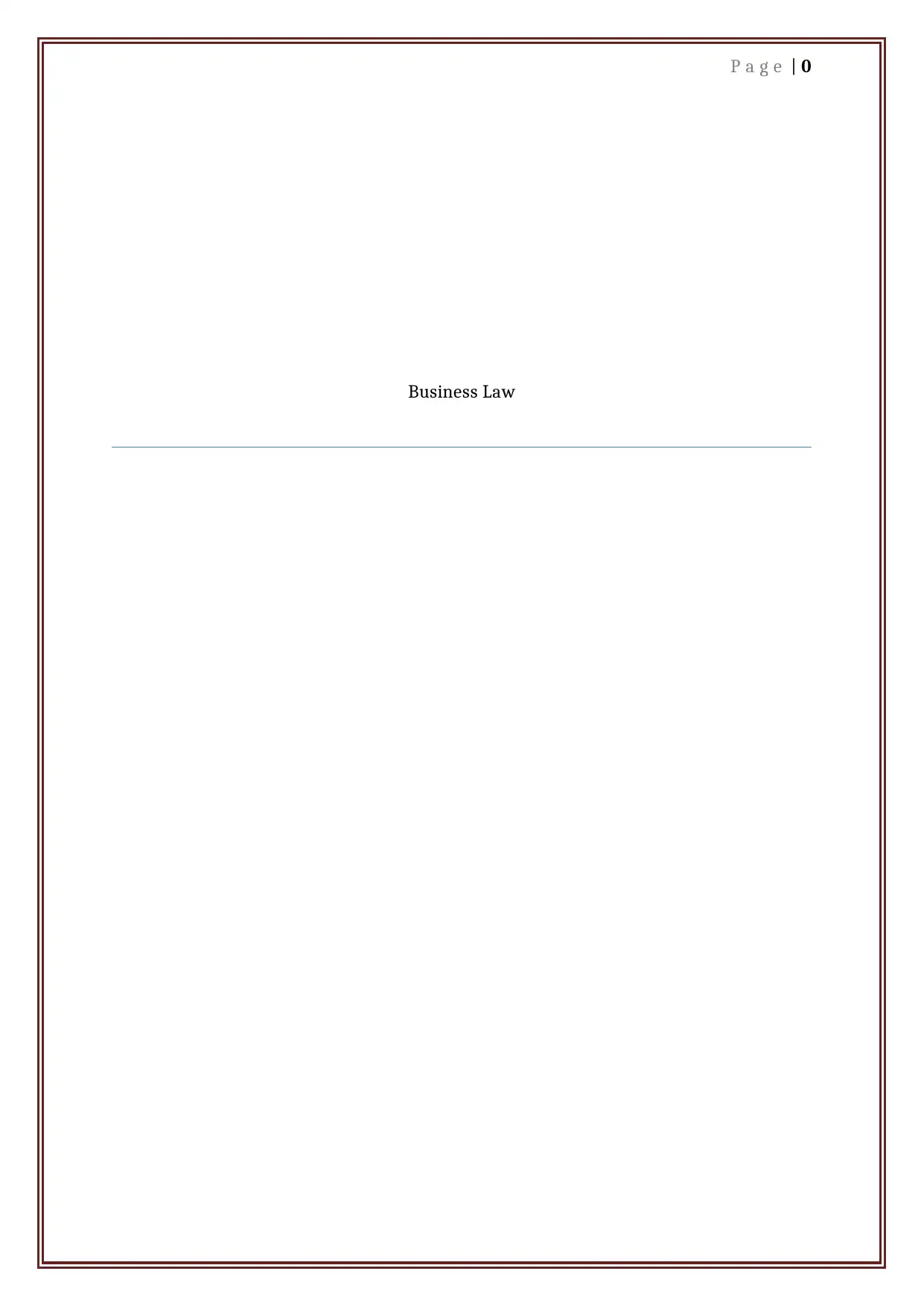
P a g e | 0
Business Law
Business Law
Secure Best Marks with AI Grader
Need help grading? Try our AI Grader for instant feedback on your assignments.
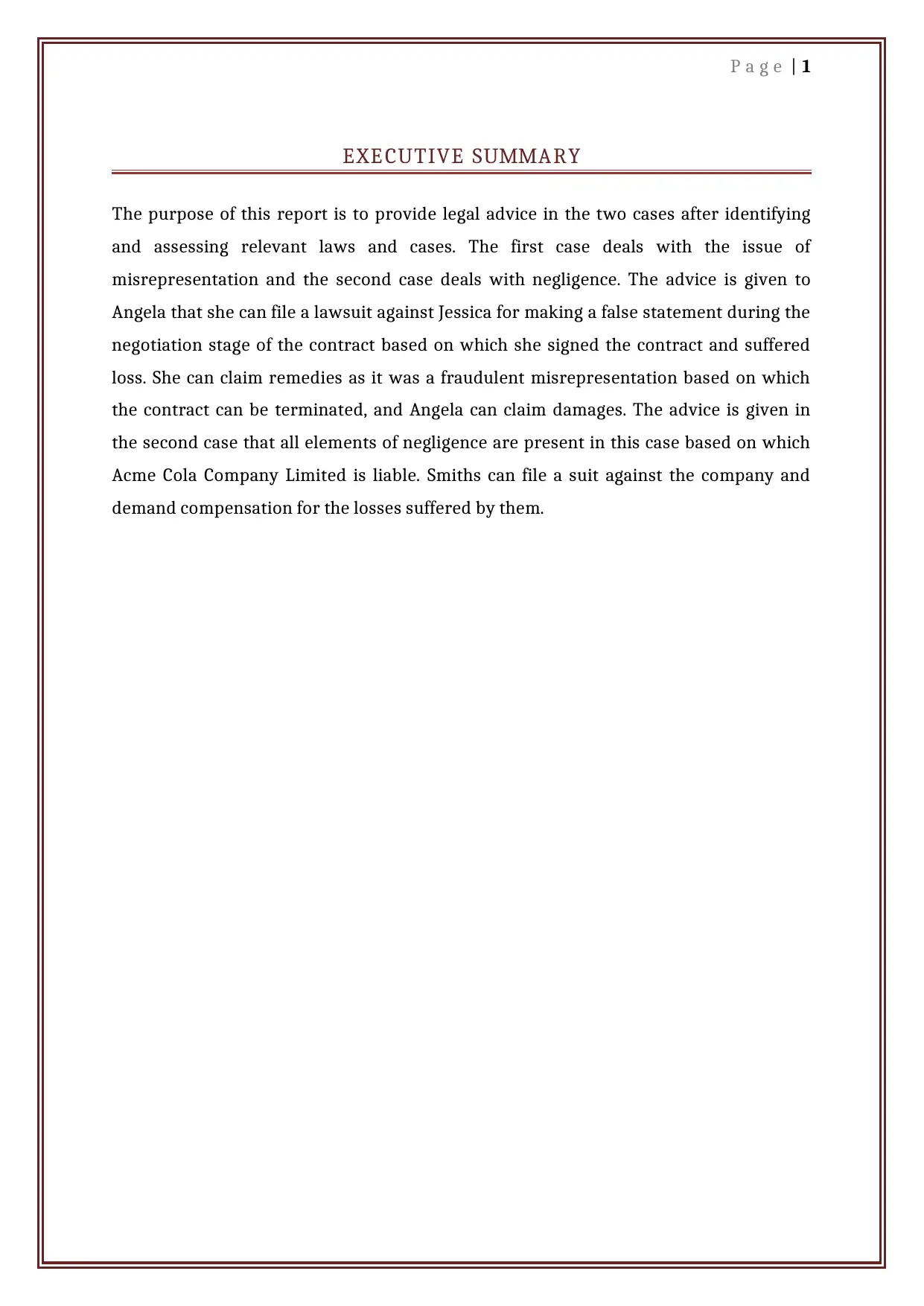
P a g e | 1
EXECUTIVE SUMMARY
The purpose of this report is to provide legal advice in the two cases after identifying
and assessing relevant laws and cases. The first case deals with the issue of
misrepresentation and the second case deals with negligence. The advice is given to
Angela that she can file a lawsuit against Jessica for making a false statement during the
negotiation stage of the contract based on which she signed the contract and suffered
loss. She can claim remedies as it was a fraudulent misrepresentation based on which
the contract can be terminated, and Angela can claim damages. The advice is given in
the second case that all elements of negligence are present in this case based on which
Acme Cola Company Limited is liable. Smiths can file a suit against the company and
demand compensation for the losses suffered by them.
EXECUTIVE SUMMARY
The purpose of this report is to provide legal advice in the two cases after identifying
and assessing relevant laws and cases. The first case deals with the issue of
misrepresentation and the second case deals with negligence. The advice is given to
Angela that she can file a lawsuit against Jessica for making a false statement during the
negotiation stage of the contract based on which she signed the contract and suffered
loss. She can claim remedies as it was a fraudulent misrepresentation based on which
the contract can be terminated, and Angela can claim damages. The advice is given in
the second case that all elements of negligence are present in this case based on which
Acme Cola Company Limited is liable. Smiths can file a suit against the company and
demand compensation for the losses suffered by them.
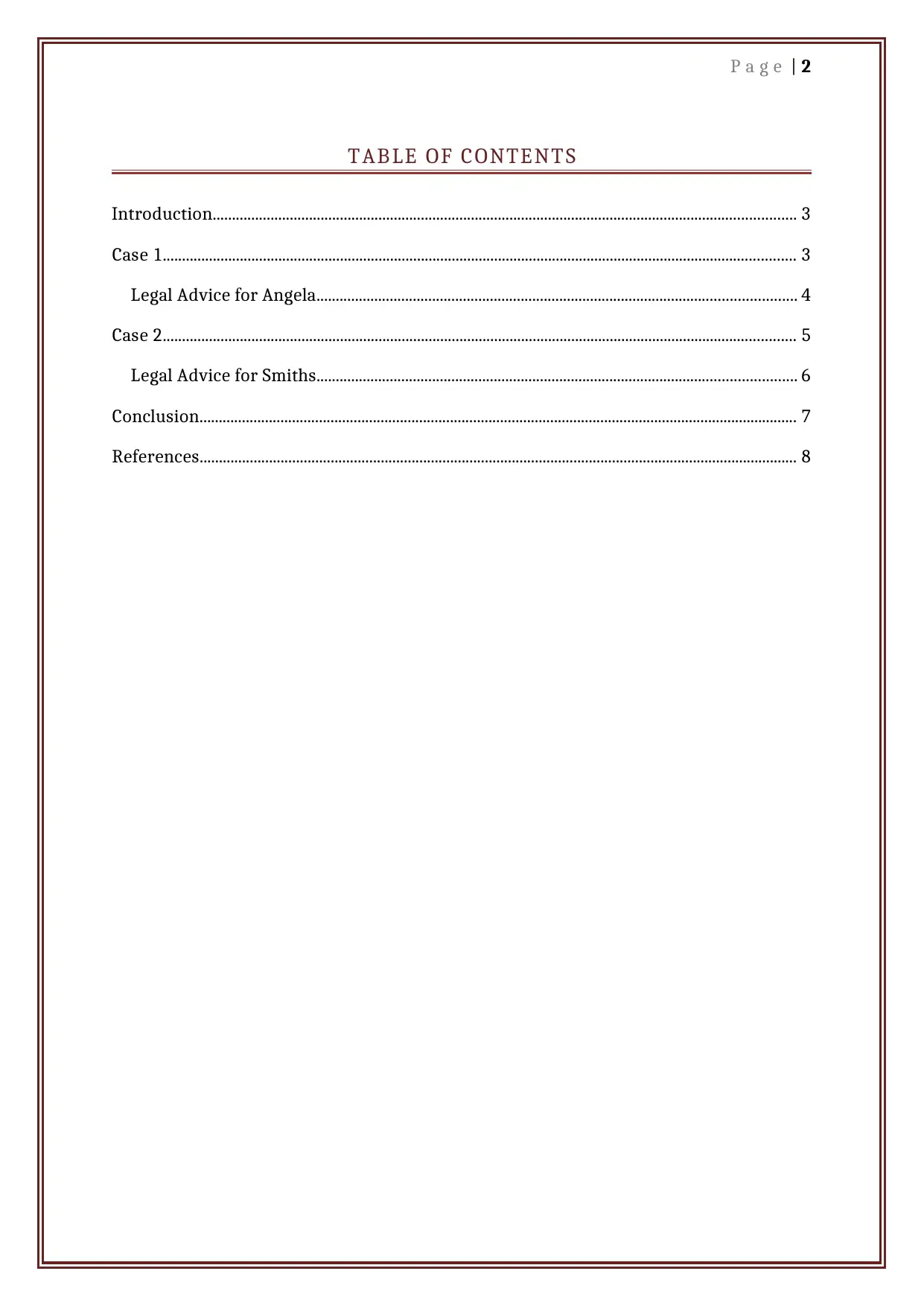
P a g e | 2
TABLE OF CONTENTS
Introduction....................................................................................................................................................... 3
Case 1.................................................................................................................................................................... 3
Legal Advice for Angela............................................................................................................................ 4
Case 2.................................................................................................................................................................... 5
Legal Advice for Smiths............................................................................................................................ 6
Conclusion........................................................................................................................................................... 7
References........................................................................................................................................................... 8
TABLE OF CONTENTS
Introduction....................................................................................................................................................... 3
Case 1.................................................................................................................................................................... 3
Legal Advice for Angela............................................................................................................................ 4
Case 2.................................................................................................................................................................... 5
Legal Advice for Smiths............................................................................................................................ 6
Conclusion........................................................................................................................................................... 7
References........................................................................................................................................................... 8
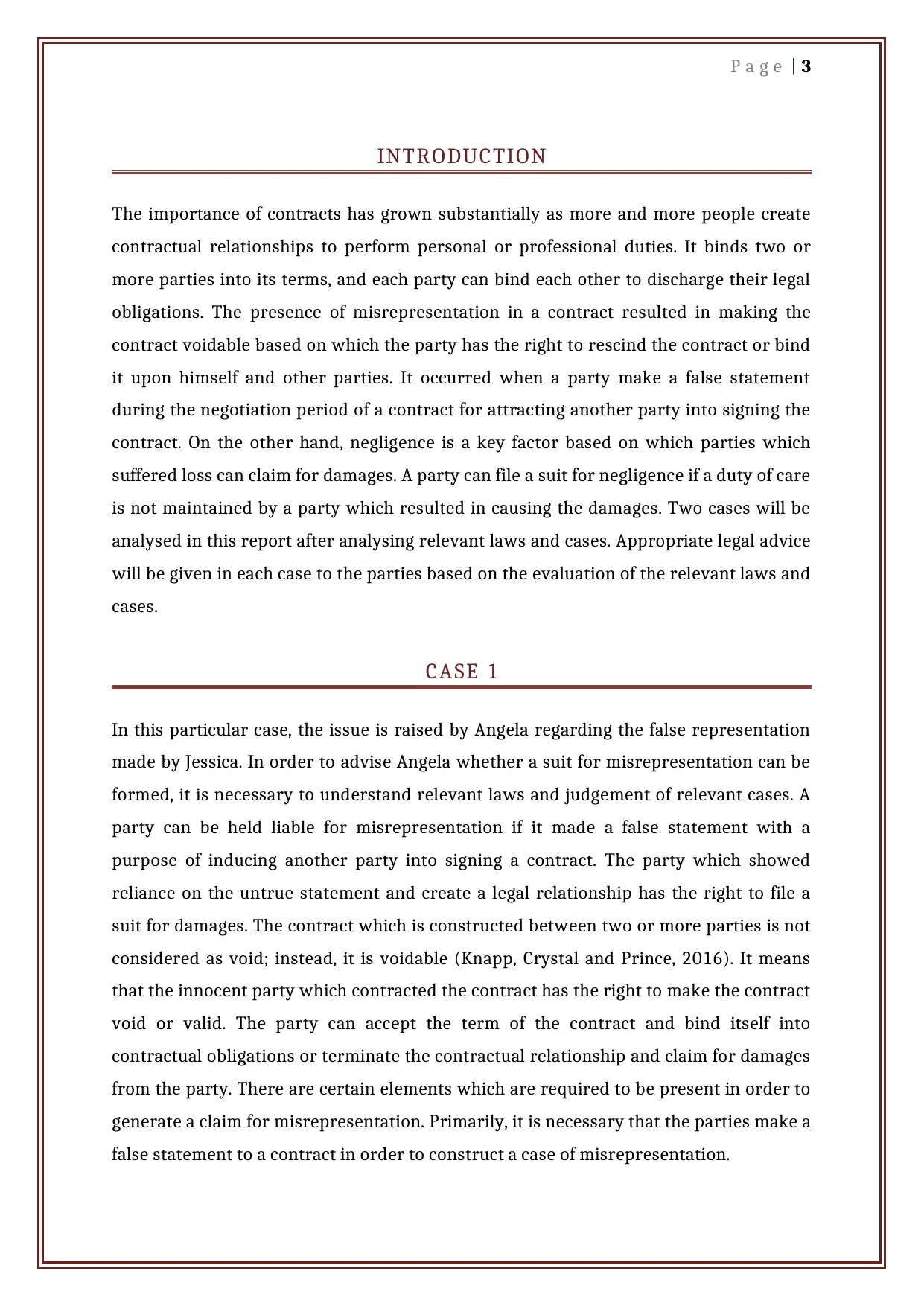
P a g e | 3
INTRODUCTION
The importance of contracts has grown substantially as more and more people create
contractual relationships to perform personal or professional duties. It binds two or
more parties into its terms, and each party can bind each other to discharge their legal
obligations. The presence of misrepresentation in a contract resulted in making the
contract voidable based on which the party has the right to rescind the contract or bind
it upon himself and other parties. It occurred when a party make a false statement
during the negotiation period of a contract for attracting another party into signing the
contract. On the other hand, negligence is a key factor based on which parties which
suffered loss can claim for damages. A party can file a suit for negligence if a duty of care
is not maintained by a party which resulted in causing the damages. Two cases will be
analysed in this report after analysing relevant laws and cases. Appropriate legal advice
will be given in each case to the parties based on the evaluation of the relevant laws and
cases.
CASE 1
In this particular case, the issue is raised by Angela regarding the false representation
made by Jessica. In order to advise Angela whether a suit for misrepresentation can be
formed, it is necessary to understand relevant laws and judgement of relevant cases. A
party can be held liable for misrepresentation if it made a false statement with a
purpose of inducing another party into signing a contract. The party which showed
reliance on the untrue statement and create a legal relationship has the right to file a
suit for damages. The contract which is constructed between two or more parties is not
considered as void; instead, it is voidable (Knapp, Crystal and Prince, 2016). It means
that the innocent party which contracted the contract has the right to make the contract
void or valid. The party can accept the term of the contract and bind itself into
contractual obligations or terminate the contractual relationship and claim for damages
from the party. There are certain elements which are required to be present in order to
generate a claim for misrepresentation. Primarily, it is necessary that the parties make a
false statement to a contract in order to construct a case of misrepresentation.
INTRODUCTION
The importance of contracts has grown substantially as more and more people create
contractual relationships to perform personal or professional duties. It binds two or
more parties into its terms, and each party can bind each other to discharge their legal
obligations. The presence of misrepresentation in a contract resulted in making the
contract voidable based on which the party has the right to rescind the contract or bind
it upon himself and other parties. It occurred when a party make a false statement
during the negotiation period of a contract for attracting another party into signing the
contract. On the other hand, negligence is a key factor based on which parties which
suffered loss can claim for damages. A party can file a suit for negligence if a duty of care
is not maintained by a party which resulted in causing the damages. Two cases will be
analysed in this report after analysing relevant laws and cases. Appropriate legal advice
will be given in each case to the parties based on the evaluation of the relevant laws and
cases.
CASE 1
In this particular case, the issue is raised by Angela regarding the false representation
made by Jessica. In order to advise Angela whether a suit for misrepresentation can be
formed, it is necessary to understand relevant laws and judgement of relevant cases. A
party can be held liable for misrepresentation if it made a false statement with a
purpose of inducing another party into signing a contract. The party which showed
reliance on the untrue statement and create a legal relationship has the right to file a
suit for damages. The contract which is constructed between two or more parties is not
considered as void; instead, it is voidable (Knapp, Crystal and Prince, 2016). It means
that the innocent party which contracted the contract has the right to make the contract
void or valid. The party can accept the term of the contract and bind itself into
contractual obligations or terminate the contractual relationship and claim for damages
from the party. There are certain elements which are required to be present in order to
generate a claim for misrepresentation. Primarily, it is necessary that the parties make a
false statement to a contract in order to construct a case of misrepresentation.
Secure Best Marks with AI Grader
Need help grading? Try our AI Grader for instant feedback on your assignments.
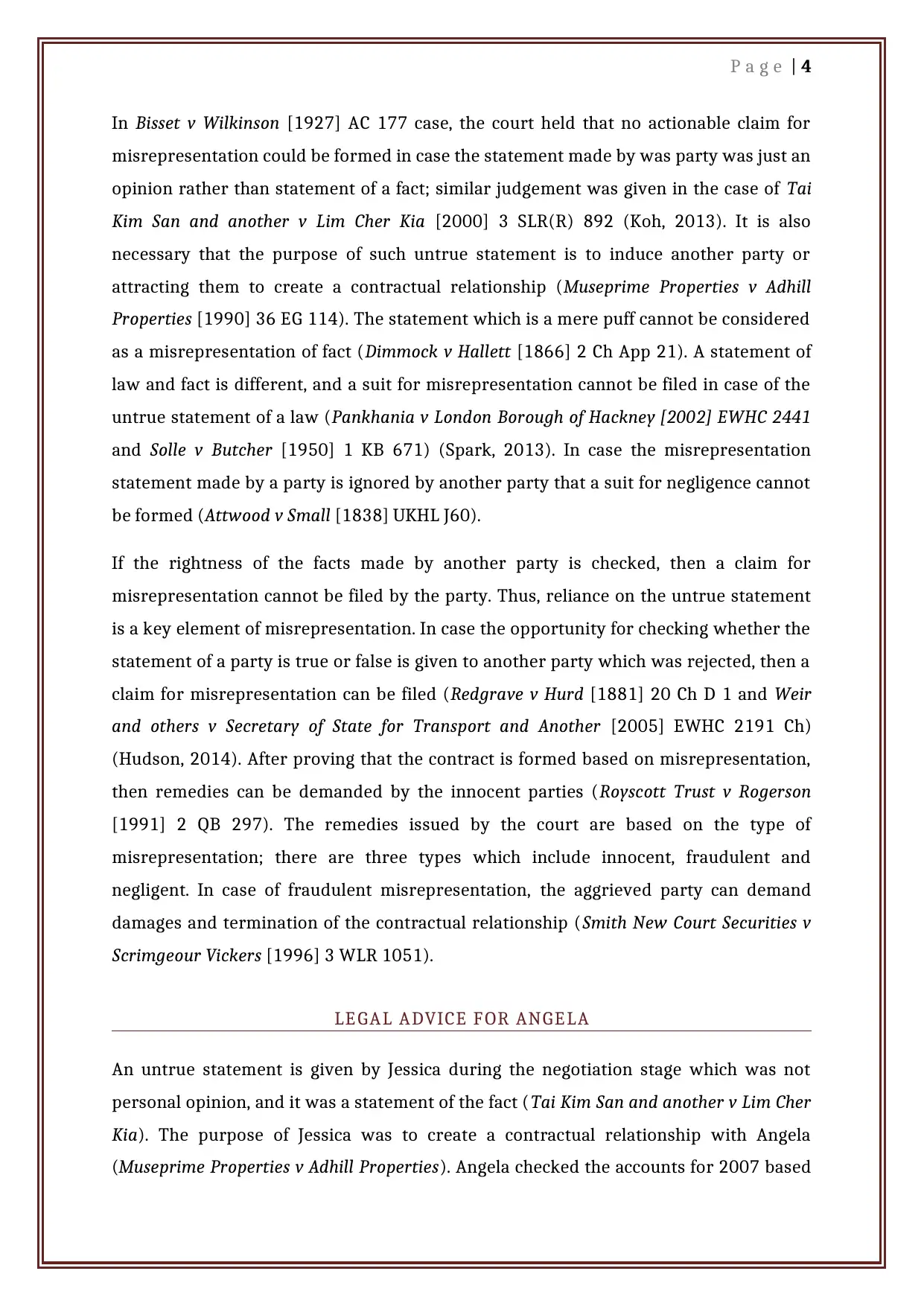
P a g e | 4
In Bisset v Wilkinson [1927] AC 177 case, the court held that no actionable claim for
misrepresentation could be formed in case the statement made by was party was just an
opinion rather than statement of a fact; similar judgement was given in the case of Tai
Kim San and another v Lim Cher Kia [2000] 3 SLR(R) 892 (Koh, 2013). It is also
necessary that the purpose of such untrue statement is to induce another party or
attracting them to create a contractual relationship (Museprime Properties v Adhill
Properties [1990] 36 EG 114). The statement which is a mere puff cannot be considered
as a misrepresentation of fact (Dimmock v Hallett [1866] 2 Ch App 21). A statement of
law and fact is different, and a suit for misrepresentation cannot be filed in case of the
untrue statement of a law (Pankhania v London Borough of Hackney [2002] EWHC 2441
and Solle v Butcher [1950] 1 KB 671) (Spark, 2013). In case the misrepresentation
statement made by a party is ignored by another party that a suit for negligence cannot
be formed (Attwood v Small [1838] UKHL J60).
If the rightness of the facts made by another party is checked, then a claim for
misrepresentation cannot be filed by the party. Thus, reliance on the untrue statement
is a key element of misrepresentation. In case the opportunity for checking whether the
statement of a party is true or false is given to another party which was rejected, then a
claim for misrepresentation can be filed (Redgrave v Hurd [1881] 20 Ch D 1 and Weir
and others v Secretary of State for Transport and Another [2005] EWHC 2191 Ch)
(Hudson, 2014). After proving that the contract is formed based on misrepresentation,
then remedies can be demanded by the innocent parties (Royscott Trust v Rogerson
[1991] 2 QB 297). The remedies issued by the court are based on the type of
misrepresentation; there are three types which include innocent, fraudulent and
negligent. In case of fraudulent misrepresentation, the aggrieved party can demand
damages and termination of the contractual relationship (Smith New Court Securities v
Scrimgeour Vickers [1996] 3 WLR 1051).
LEGAL ADVICE FOR ANGELA
An untrue statement is given by Jessica during the negotiation stage which was not
personal opinion, and it was a statement of the fact (Tai Kim San and another v Lim Cher
Kia). The purpose of Jessica was to create a contractual relationship with Angela
(Museprime Properties v Adhill Properties). Angela checked the accounts for 2007 based
In Bisset v Wilkinson [1927] AC 177 case, the court held that no actionable claim for
misrepresentation could be formed in case the statement made by was party was just an
opinion rather than statement of a fact; similar judgement was given in the case of Tai
Kim San and another v Lim Cher Kia [2000] 3 SLR(R) 892 (Koh, 2013). It is also
necessary that the purpose of such untrue statement is to induce another party or
attracting them to create a contractual relationship (Museprime Properties v Adhill
Properties [1990] 36 EG 114). The statement which is a mere puff cannot be considered
as a misrepresentation of fact (Dimmock v Hallett [1866] 2 Ch App 21). A statement of
law and fact is different, and a suit for misrepresentation cannot be filed in case of the
untrue statement of a law (Pankhania v London Borough of Hackney [2002] EWHC 2441
and Solle v Butcher [1950] 1 KB 671) (Spark, 2013). In case the misrepresentation
statement made by a party is ignored by another party that a suit for negligence cannot
be formed (Attwood v Small [1838] UKHL J60).
If the rightness of the facts made by another party is checked, then a claim for
misrepresentation cannot be filed by the party. Thus, reliance on the untrue statement
is a key element of misrepresentation. In case the opportunity for checking whether the
statement of a party is true or false is given to another party which was rejected, then a
claim for misrepresentation can be filed (Redgrave v Hurd [1881] 20 Ch D 1 and Weir
and others v Secretary of State for Transport and Another [2005] EWHC 2191 Ch)
(Hudson, 2014). After proving that the contract is formed based on misrepresentation,
then remedies can be demanded by the innocent parties (Royscott Trust v Rogerson
[1991] 2 QB 297). The remedies issued by the court are based on the type of
misrepresentation; there are three types which include innocent, fraudulent and
negligent. In case of fraudulent misrepresentation, the aggrieved party can demand
damages and termination of the contractual relationship (Smith New Court Securities v
Scrimgeour Vickers [1996] 3 WLR 1051).
LEGAL ADVICE FOR ANGELA
An untrue statement is given by Jessica during the negotiation stage which was not
personal opinion, and it was a statement of the fact (Tai Kim San and another v Lim Cher
Kia). The purpose of Jessica was to create a contractual relationship with Angela
(Museprime Properties v Adhill Properties). Angela checked the accounts for 2007 based
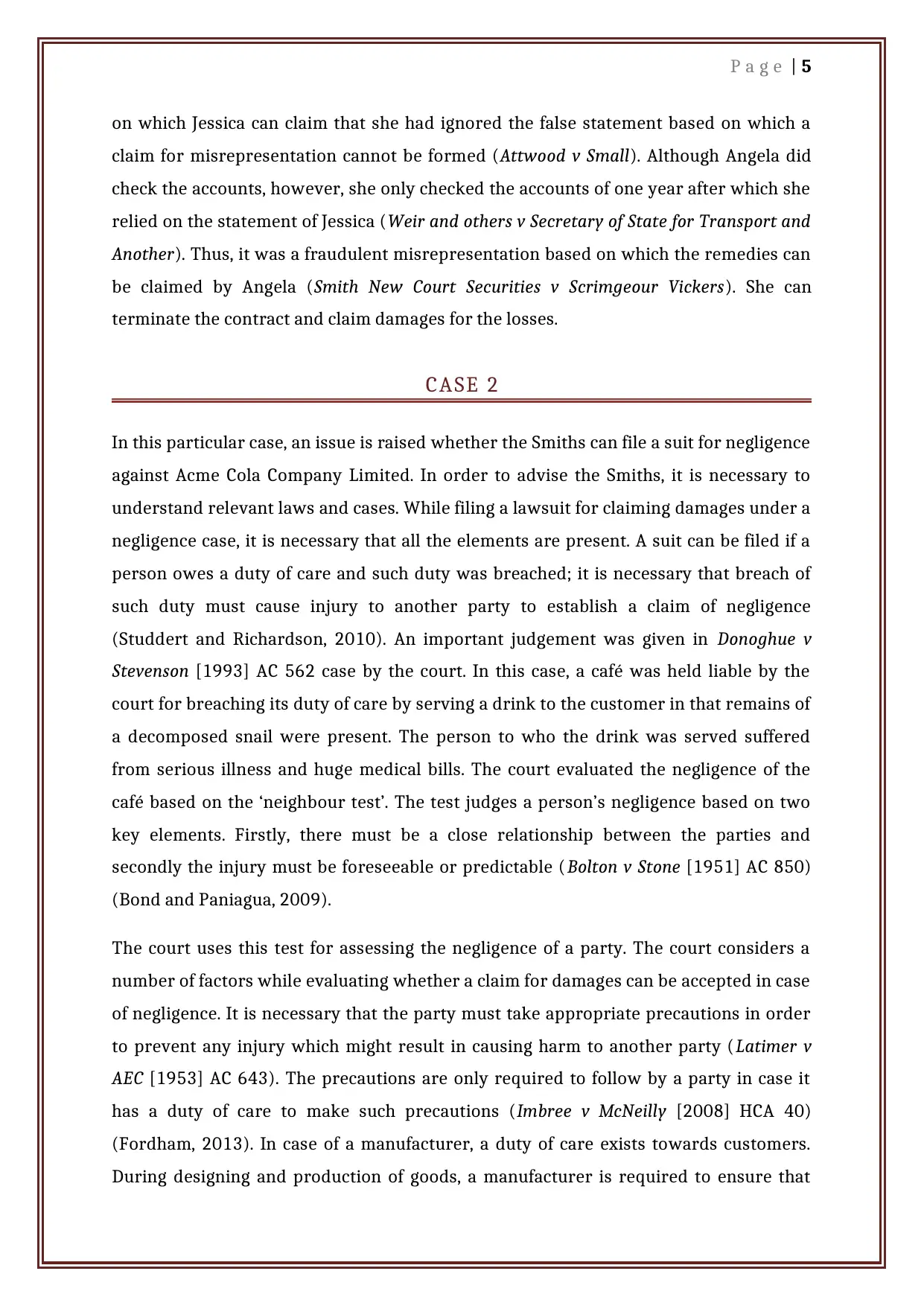
P a g e | 5
on which Jessica can claim that she had ignored the false statement based on which a
claim for misrepresentation cannot be formed (Attwood v Small). Although Angela did
check the accounts, however, she only checked the accounts of one year after which she
relied on the statement of Jessica (Weir and others v Secretary of State for Transport and
Another). Thus, it was a fraudulent misrepresentation based on which the remedies can
be claimed by Angela (Smith New Court Securities v Scrimgeour Vickers). She can
terminate the contract and claim damages for the losses.
CASE 2
In this particular case, an issue is raised whether the Smiths can file a suit for negligence
against Acme Cola Company Limited. In order to advise the Smiths, it is necessary to
understand relevant laws and cases. While filing a lawsuit for claiming damages under a
negligence case, it is necessary that all the elements are present. A suit can be filed if a
person owes a duty of care and such duty was breached; it is necessary that breach of
such duty must cause injury to another party to establish a claim of negligence
(Studdert and Richardson, 2010). An important judgement was given in Donoghue v
Stevenson [1993] AC 562 case by the court. In this case, a café was held liable by the
court for breaching its duty of care by serving a drink to the customer in that remains of
a decomposed snail were present. The person to who the drink was served suffered
from serious illness and huge medical bills. The court evaluated the negligence of the
café based on the ‘neighbour test’. The test judges a person’s negligence based on two
key elements. Firstly, there must be a close relationship between the parties and
secondly the injury must be foreseeable or predictable (Bolton v Stone [1951] AC 850)
(Bond and Paniagua, 2009).
The court uses this test for assessing the negligence of a party. The court considers a
number of factors while evaluating whether a claim for damages can be accepted in case
of negligence. It is necessary that the party must take appropriate precautions in order
to prevent any injury which might result in causing harm to another party (Latimer v
AEC [1953] AC 643). The precautions are only required to follow by a party in case it
has a duty of care to make such precautions (Imbree v McNeilly [2008] HCA 40)
(Fordham, 2013). In case of a manufacturer, a duty of care exists towards customers.
During designing and production of goods, a manufacturer is required to ensure that
on which Jessica can claim that she had ignored the false statement based on which a
claim for misrepresentation cannot be formed (Attwood v Small). Although Angela did
check the accounts, however, she only checked the accounts of one year after which she
relied on the statement of Jessica (Weir and others v Secretary of State for Transport and
Another). Thus, it was a fraudulent misrepresentation based on which the remedies can
be claimed by Angela (Smith New Court Securities v Scrimgeour Vickers). She can
terminate the contract and claim damages for the losses.
CASE 2
In this particular case, an issue is raised whether the Smiths can file a suit for negligence
against Acme Cola Company Limited. In order to advise the Smiths, it is necessary to
understand relevant laws and cases. While filing a lawsuit for claiming damages under a
negligence case, it is necessary that all the elements are present. A suit can be filed if a
person owes a duty of care and such duty was breached; it is necessary that breach of
such duty must cause injury to another party to establish a claim of negligence
(Studdert and Richardson, 2010). An important judgement was given in Donoghue v
Stevenson [1993] AC 562 case by the court. In this case, a café was held liable by the
court for breaching its duty of care by serving a drink to the customer in that remains of
a decomposed snail were present. The person to who the drink was served suffered
from serious illness and huge medical bills. The court evaluated the negligence of the
café based on the ‘neighbour test’. The test judges a person’s negligence based on two
key elements. Firstly, there must be a close relationship between the parties and
secondly the injury must be foreseeable or predictable (Bolton v Stone [1951] AC 850)
(Bond and Paniagua, 2009).
The court uses this test for assessing the negligence of a party. The court considers a
number of factors while evaluating whether a claim for damages can be accepted in case
of negligence. It is necessary that the party must take appropriate precautions in order
to prevent any injury which might result in causing harm to another party (Latimer v
AEC [1953] AC 643). The precautions are only required to follow by a party in case it
has a duty of care to make such precautions (Imbree v McNeilly [2008] HCA 40)
(Fordham, 2013). In case of a manufacturer, a duty of care exists towards customers.
During designing and production of goods, a manufacturer is required to ensure that
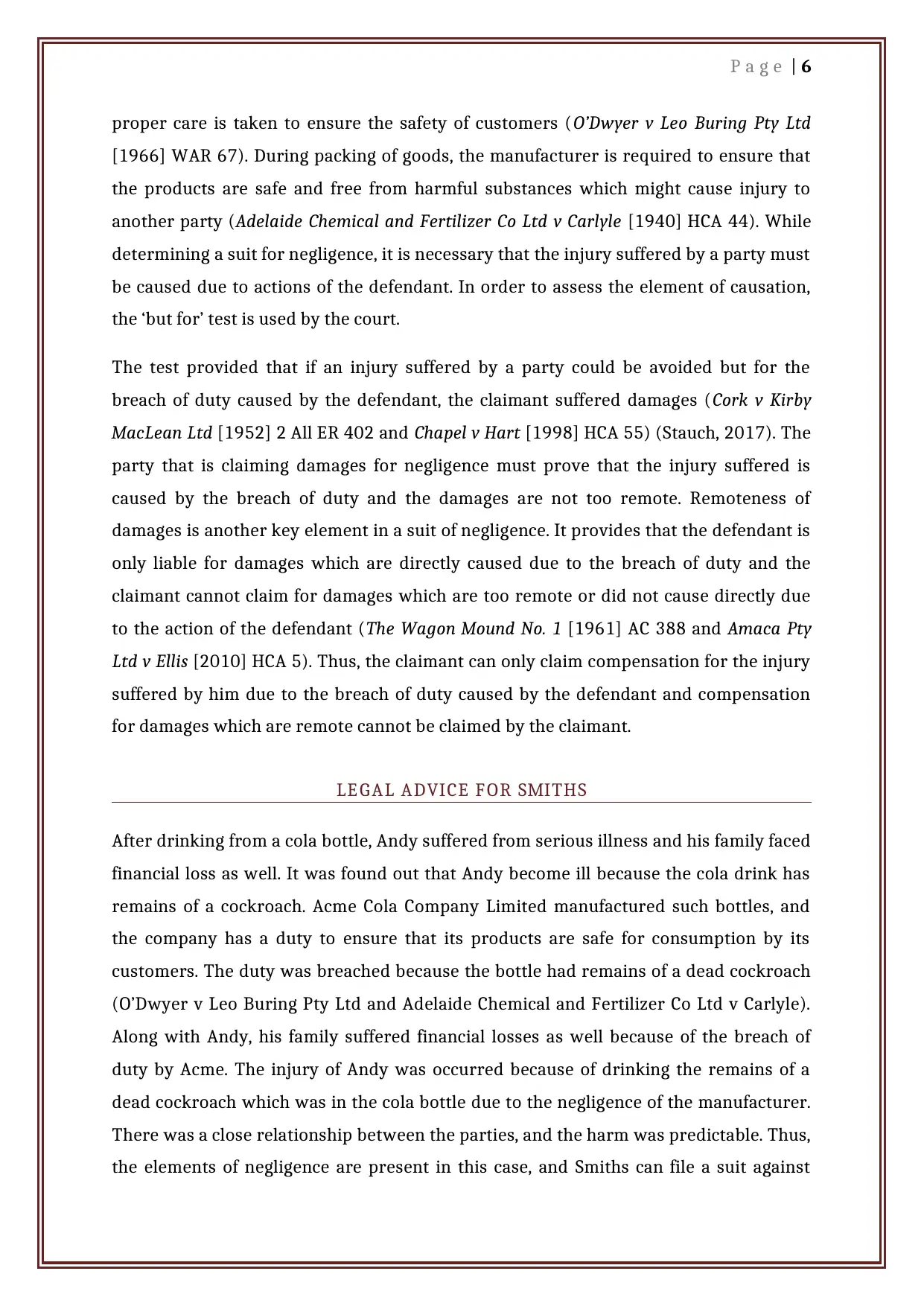
P a g e | 6
proper care is taken to ensure the safety of customers (O’Dwyer v Leo Buring Pty Ltd
[1966] WAR 67). During packing of goods, the manufacturer is required to ensure that
the products are safe and free from harmful substances which might cause injury to
another party (Adelaide Chemical and Fertilizer Co Ltd v Carlyle [1940] HCA 44). While
determining a suit for negligence, it is necessary that the injury suffered by a party must
be caused due to actions of the defendant. In order to assess the element of causation,
the ‘but for’ test is used by the court.
The test provided that if an injury suffered by a party could be avoided but for the
breach of duty caused by the defendant, the claimant suffered damages (Cork v Kirby
MacLean Ltd [1952] 2 All ER 402 and Chapel v Hart [1998] HCA 55) (Stauch, 2017). The
party that is claiming damages for negligence must prove that the injury suffered is
caused by the breach of duty and the damages are not too remote. Remoteness of
damages is another key element in a suit of negligence. It provides that the defendant is
only liable for damages which are directly caused due to the breach of duty and the
claimant cannot claim for damages which are too remote or did not cause directly due
to the action of the defendant (The Wagon Mound No. 1 [1961] AC 388 and Amaca Pty
Ltd v Ellis [2010] HCA 5). Thus, the claimant can only claim compensation for the injury
suffered by him due to the breach of duty caused by the defendant and compensation
for damages which are remote cannot be claimed by the claimant.
LEGAL ADVICE FOR SMITHS
After drinking from a cola bottle, Andy suffered from serious illness and his family faced
financial loss as well. It was found out that Andy become ill because the cola drink has
remains of a cockroach. Acme Cola Company Limited manufactured such bottles, and
the company has a duty to ensure that its products are safe for consumption by its
customers. The duty was breached because the bottle had remains of a dead cockroach
(O’Dwyer v Leo Buring Pty Ltd and Adelaide Chemical and Fertilizer Co Ltd v Carlyle).
Along with Andy, his family suffered financial losses as well because of the breach of
duty by Acme. The injury of Andy was occurred because of drinking the remains of a
dead cockroach which was in the cola bottle due to the negligence of the manufacturer.
There was a close relationship between the parties, and the harm was predictable. Thus,
the elements of negligence are present in this case, and Smiths can file a suit against
proper care is taken to ensure the safety of customers (O’Dwyer v Leo Buring Pty Ltd
[1966] WAR 67). During packing of goods, the manufacturer is required to ensure that
the products are safe and free from harmful substances which might cause injury to
another party (Adelaide Chemical and Fertilizer Co Ltd v Carlyle [1940] HCA 44). While
determining a suit for negligence, it is necessary that the injury suffered by a party must
be caused due to actions of the defendant. In order to assess the element of causation,
the ‘but for’ test is used by the court.
The test provided that if an injury suffered by a party could be avoided but for the
breach of duty caused by the defendant, the claimant suffered damages (Cork v Kirby
MacLean Ltd [1952] 2 All ER 402 and Chapel v Hart [1998] HCA 55) (Stauch, 2017). The
party that is claiming damages for negligence must prove that the injury suffered is
caused by the breach of duty and the damages are not too remote. Remoteness of
damages is another key element in a suit of negligence. It provides that the defendant is
only liable for damages which are directly caused due to the breach of duty and the
claimant cannot claim for damages which are too remote or did not cause directly due
to the action of the defendant (The Wagon Mound No. 1 [1961] AC 388 and Amaca Pty
Ltd v Ellis [2010] HCA 5). Thus, the claimant can only claim compensation for the injury
suffered by him due to the breach of duty caused by the defendant and compensation
for damages which are remote cannot be claimed by the claimant.
LEGAL ADVICE FOR SMITHS
After drinking from a cola bottle, Andy suffered from serious illness and his family faced
financial loss as well. It was found out that Andy become ill because the cola drink has
remains of a cockroach. Acme Cola Company Limited manufactured such bottles, and
the company has a duty to ensure that its products are safe for consumption by its
customers. The duty was breached because the bottle had remains of a dead cockroach
(O’Dwyer v Leo Buring Pty Ltd and Adelaide Chemical and Fertilizer Co Ltd v Carlyle).
Along with Andy, his family suffered financial losses as well because of the breach of
duty by Acme. The injury of Andy was occurred because of drinking the remains of a
dead cockroach which was in the cola bottle due to the negligence of the manufacturer.
There was a close relationship between the parties, and the harm was predictable. Thus,
the elements of negligence are present in this case, and Smiths can file a suit against
Paraphrase This Document
Need a fresh take? Get an instant paraphrase of this document with our AI Paraphraser

P a g e | 7
Acme. They can claim for compensation for the loss suffered by them due to the illness
of Andy.
Acme. They can claim for compensation for the loss suffered by them due to the illness
of Andy.
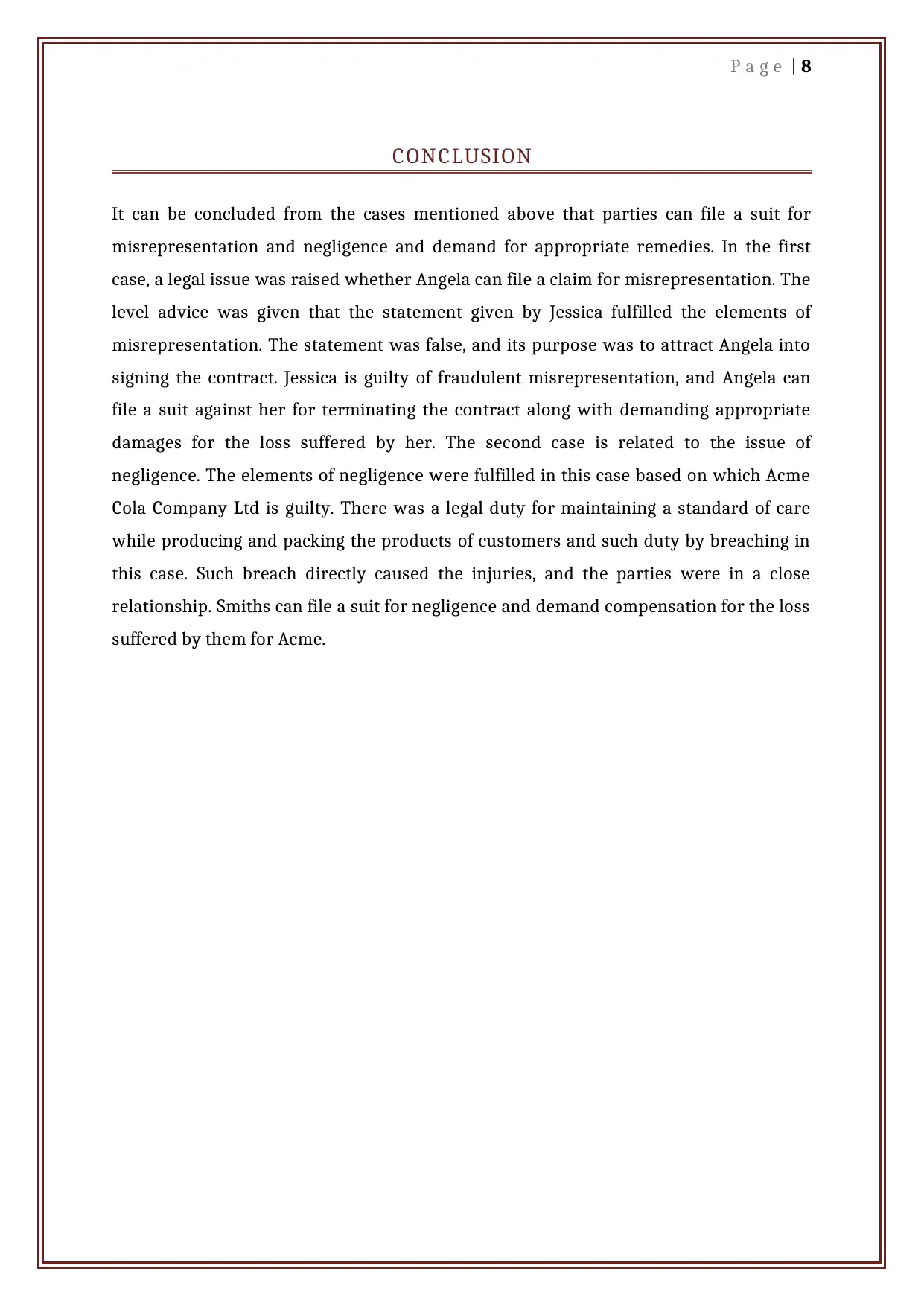
P a g e | 8
CONCLUSION
It can be concluded from the cases mentioned above that parties can file a suit for
misrepresentation and negligence and demand for appropriate remedies. In the first
case, a legal issue was raised whether Angela can file a claim for misrepresentation. The
level advice was given that the statement given by Jessica fulfilled the elements of
misrepresentation. The statement was false, and its purpose was to attract Angela into
signing the contract. Jessica is guilty of fraudulent misrepresentation, and Angela can
file a suit against her for terminating the contract along with demanding appropriate
damages for the loss suffered by her. The second case is related to the issue of
negligence. The elements of negligence were fulfilled in this case based on which Acme
Cola Company Ltd is guilty. There was a legal duty for maintaining a standard of care
while producing and packing the products of customers and such duty by breaching in
this case. Such breach directly caused the injuries, and the parties were in a close
relationship. Smiths can file a suit for negligence and demand compensation for the loss
suffered by them for Acme.
CONCLUSION
It can be concluded from the cases mentioned above that parties can file a suit for
misrepresentation and negligence and demand for appropriate remedies. In the first
case, a legal issue was raised whether Angela can file a claim for misrepresentation. The
level advice was given that the statement given by Jessica fulfilled the elements of
misrepresentation. The statement was false, and its purpose was to attract Angela into
signing the contract. Jessica is guilty of fraudulent misrepresentation, and Angela can
file a suit against her for terminating the contract along with demanding appropriate
damages for the loss suffered by her. The second case is related to the issue of
negligence. The elements of negligence were fulfilled in this case based on which Acme
Cola Company Ltd is guilty. There was a legal duty for maintaining a standard of care
while producing and packing the products of customers and such duty by breaching in
this case. Such breach directly caused the injuries, and the parties were in a close
relationship. Smiths can file a suit for negligence and demand compensation for the loss
suffered by them for Acme.
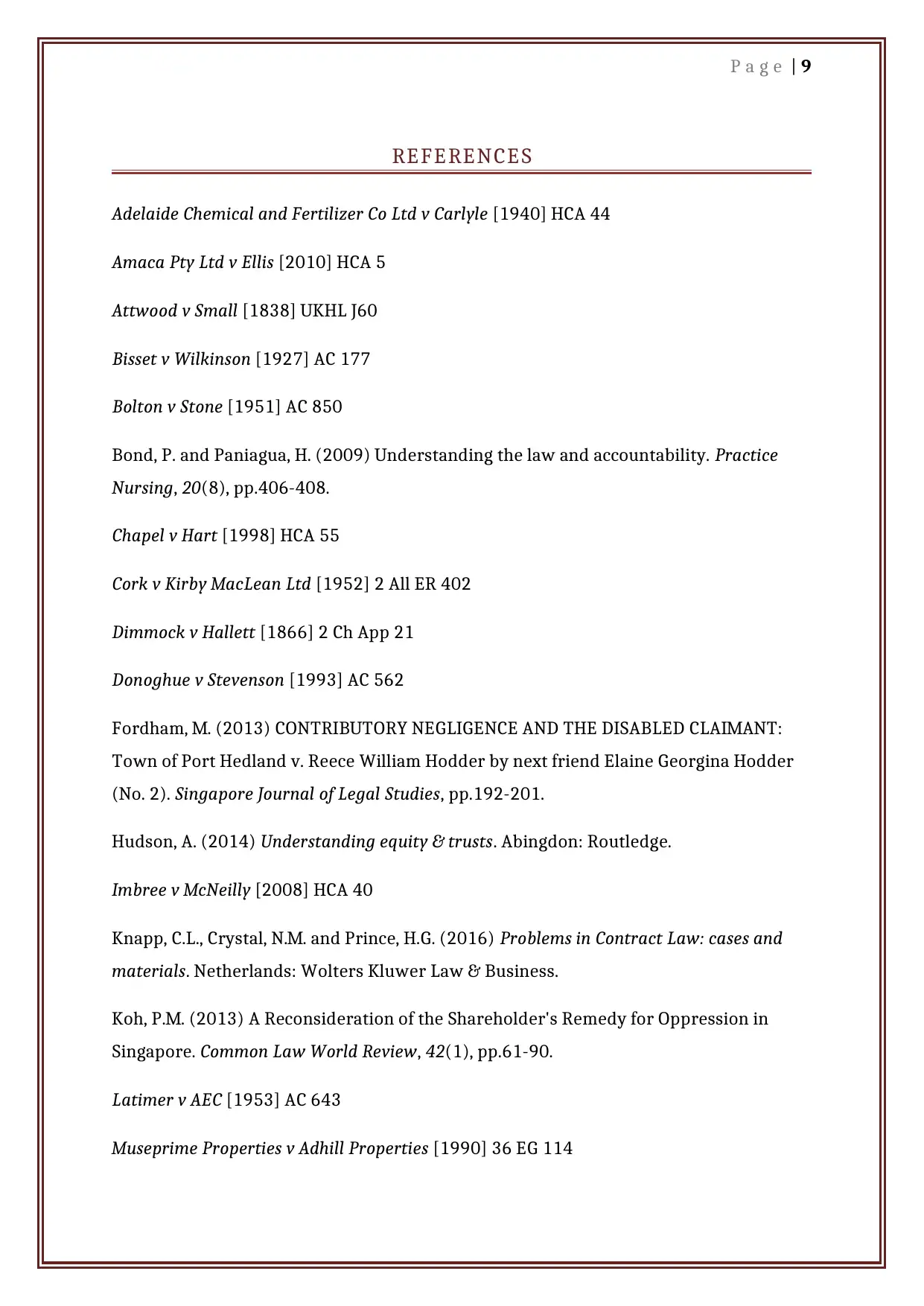
P a g e | 9
REFERENCES
Adelaide Chemical and Fertilizer Co Ltd v Carlyle [1940] HCA 44
Amaca Pty Ltd v Ellis [2010] HCA 5
Attwood v Small [1838] UKHL J60
Bisset v Wilkinson [1927] AC 177
Bolton v Stone [1951] AC 850
Bond, P. and Paniagua, H. (2009) Understanding the law and accountability. Practice
Nursing, 20(8), pp.406-408.
Chapel v Hart [1998] HCA 55
Cork v Kirby MacLean Ltd [1952] 2 All ER 402
Dimmock v Hallett [1866] 2 Ch App 21
Donoghue v Stevenson [1993] AC 562
Fordham, M. (2013) CONTRIBUTORY NEGLIGENCE AND THE DISABLED CLAIMANT:
Town of Port Hedland v. Reece William Hodder by next friend Elaine Georgina Hodder
(No. 2). Singapore Journal of Legal Studies, pp.192-201.
Hudson, A. (2014) Understanding equity & trusts. Abingdon: Routledge.
Imbree v McNeilly [2008] HCA 40
Knapp, C.L., Crystal, N.M. and Prince, H.G. (2016) Problems in Contract Law: cases and
materials. Netherlands: Wolters Kluwer Law & Business.
Koh, P.M. (2013) A Reconsideration of the Shareholder's Remedy for Oppression in
Singapore. Common Law World Review, 42(1), pp.61-90.
Latimer v AEC [1953] AC 643
Museprime Properties v Adhill Properties [1990] 36 EG 114
REFERENCES
Adelaide Chemical and Fertilizer Co Ltd v Carlyle [1940] HCA 44
Amaca Pty Ltd v Ellis [2010] HCA 5
Attwood v Small [1838] UKHL J60
Bisset v Wilkinson [1927] AC 177
Bolton v Stone [1951] AC 850
Bond, P. and Paniagua, H. (2009) Understanding the law and accountability. Practice
Nursing, 20(8), pp.406-408.
Chapel v Hart [1998] HCA 55
Cork v Kirby MacLean Ltd [1952] 2 All ER 402
Dimmock v Hallett [1866] 2 Ch App 21
Donoghue v Stevenson [1993] AC 562
Fordham, M. (2013) CONTRIBUTORY NEGLIGENCE AND THE DISABLED CLAIMANT:
Town of Port Hedland v. Reece William Hodder by next friend Elaine Georgina Hodder
(No. 2). Singapore Journal of Legal Studies, pp.192-201.
Hudson, A. (2014) Understanding equity & trusts. Abingdon: Routledge.
Imbree v McNeilly [2008] HCA 40
Knapp, C.L., Crystal, N.M. and Prince, H.G. (2016) Problems in Contract Law: cases and
materials. Netherlands: Wolters Kluwer Law & Business.
Koh, P.M. (2013) A Reconsideration of the Shareholder's Remedy for Oppression in
Singapore. Common Law World Review, 42(1), pp.61-90.
Latimer v AEC [1953] AC 643
Museprime Properties v Adhill Properties [1990] 36 EG 114
Secure Best Marks with AI Grader
Need help grading? Try our AI Grader for instant feedback on your assignments.
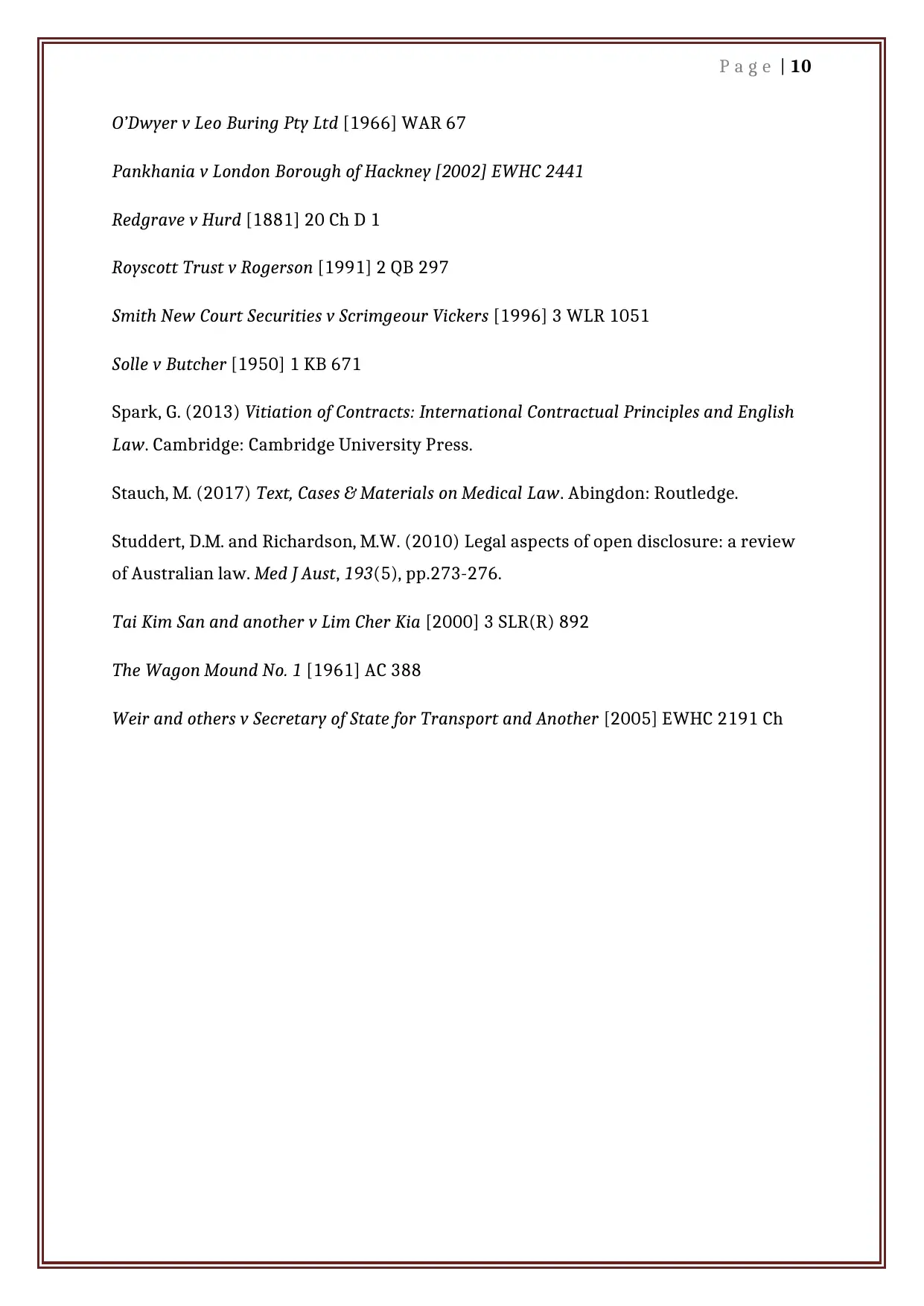
P a g e | 10
O’Dwyer v Leo Buring Pty Ltd [1966] WAR 67
Pankhania v London Borough of Hackney [2002] EWHC 2441
Redgrave v Hurd [1881] 20 Ch D 1
Royscott Trust v Rogerson [1991] 2 QB 297
Smith New Court Securities v Scrimgeour Vickers [1996] 3 WLR 1051
Solle v Butcher [1950] 1 KB 671
Spark, G. (2013) Vitiation of Contracts: International Contractual Principles and English
Law. Cambridge: Cambridge University Press.
Stauch, M. (2017) Text, Cases & Materials on Medical Law. Abingdon: Routledge.
Studdert, D.M. and Richardson, M.W. (2010) Legal aspects of open disclosure: a review
of Australian law. Med J Aust, 193(5), pp.273-276.
Tai Kim San and another v Lim Cher Kia [2000] 3 SLR(R) 892
The Wagon Mound No. 1 [1961] AC 388
Weir and others v Secretary of State for Transport and Another [2005] EWHC 2191 Ch
O’Dwyer v Leo Buring Pty Ltd [1966] WAR 67
Pankhania v London Borough of Hackney [2002] EWHC 2441
Redgrave v Hurd [1881] 20 Ch D 1
Royscott Trust v Rogerson [1991] 2 QB 297
Smith New Court Securities v Scrimgeour Vickers [1996] 3 WLR 1051
Solle v Butcher [1950] 1 KB 671
Spark, G. (2013) Vitiation of Contracts: International Contractual Principles and English
Law. Cambridge: Cambridge University Press.
Stauch, M. (2017) Text, Cases & Materials on Medical Law. Abingdon: Routledge.
Studdert, D.M. and Richardson, M.W. (2010) Legal aspects of open disclosure: a review
of Australian law. Med J Aust, 193(5), pp.273-276.
Tai Kim San and another v Lim Cher Kia [2000] 3 SLR(R) 892
The Wagon Mound No. 1 [1961] AC 388
Weir and others v Secretary of State for Transport and Another [2005] EWHC 2191 Ch
1 out of 11
Related Documents
Your All-in-One AI-Powered Toolkit for Academic Success.
+13062052269
info@desklib.com
Available 24*7 on WhatsApp / Email
![[object Object]](/_next/static/media/star-bottom.7253800d.svg)
Unlock your academic potential
© 2024 | Zucol Services PVT LTD | All rights reserved.




